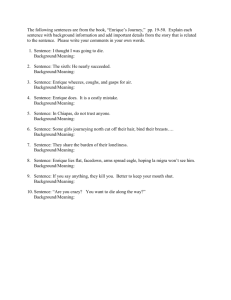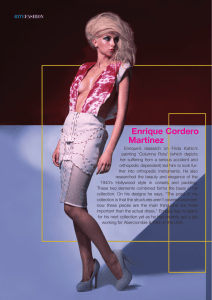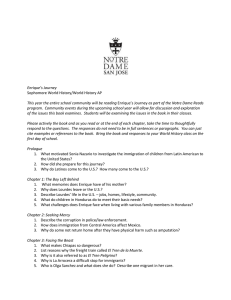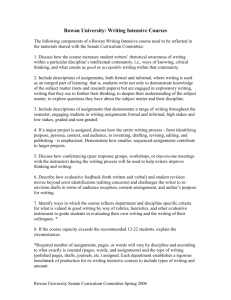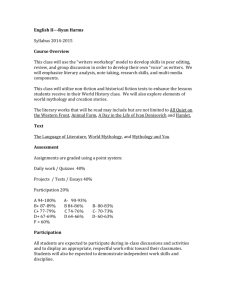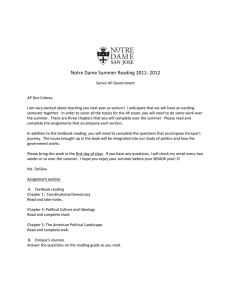CTE Workshop Handout-Revised
advertisement
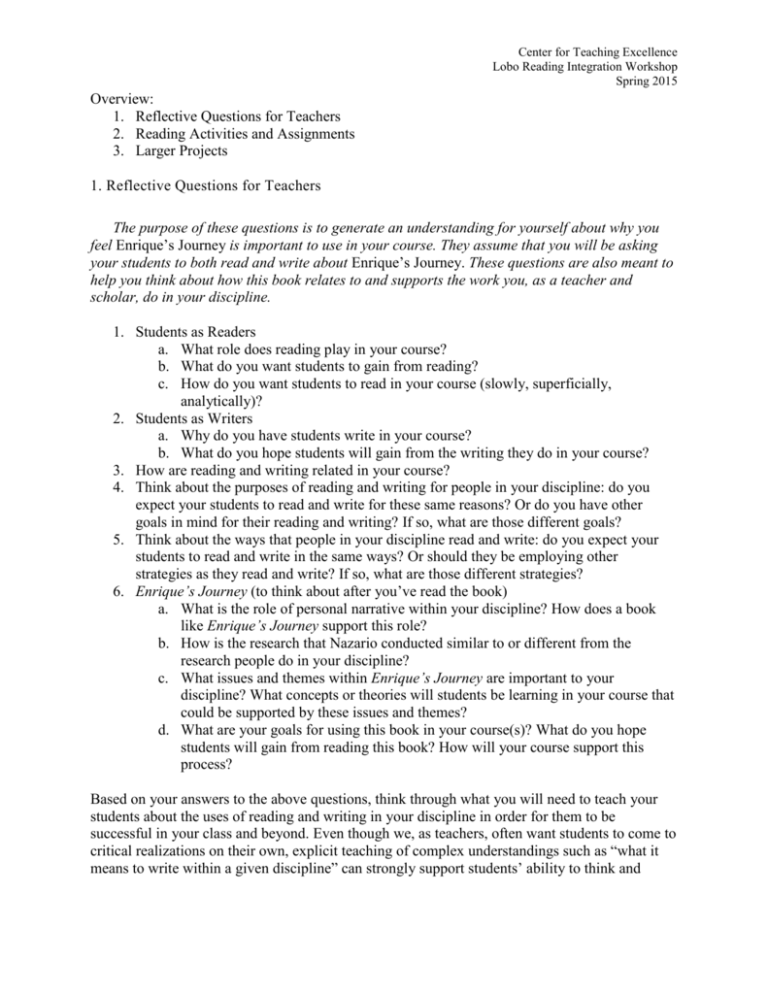
Center for Teaching Excellence Lobo Reading Integration Workshop Spring 2015 Overview: 1. Reflective Questions for Teachers 2. Reading Activities and Assignments 3. Larger Projects 1. Reflective Questions for Teachers The purpose of these questions is to generate an understanding for yourself about why you feel Enrique’s Journey is important to use in your course. They assume that you will be asking your students to both read and write about Enrique’s Journey. These questions are also meant to help you think about how this book relates to and supports the work you, as a teacher and scholar, do in your discipline. 1. Students as Readers a. What role does reading play in your course? b. What do you want students to gain from reading? c. How do you want students to read in your course (slowly, superficially, analytically)? 2. Students as Writers a. Why do you have students write in your course? b. What do you hope students will gain from the writing they do in your course? 3. How are reading and writing related in your course? 4. Think about the purposes of reading and writing for people in your discipline: do you expect your students to read and write for these same reasons? Or do you have other goals in mind for their reading and writing? If so, what are those different goals? 5. Think about the ways that people in your discipline read and write: do you expect your students to read and write in the same ways? Or should they be employing other strategies as they read and write? If so, what are those different strategies? 6. Enrique’s Journey (to think about after you’ve read the book) a. What is the role of personal narrative within your discipline? How does a book like Enrique’s Journey support this role? b. How is the research that Nazario conducted similar to or different from the research people do in your discipline? c. What issues and themes within Enrique’s Journey are important to your discipline? What concepts or theories will students be learning in your course that could be supported by these issues and themes? d. What are your goals for using this book in your course(s)? What do you hope students will gain from reading this book? How will your course support this process? Based on your answers to the above questions, think through what you will need to teach your students about the uses of reading and writing in your discipline in order for them to be successful in your class and beyond. Even though we, as teachers, often want students to come to critical realizations on their own, explicit teaching of complex understandings such as “what it means to write within a given discipline” can strongly support students’ ability to think and Center for Teaching Excellence Lobo Reading Integration Workshop Spring 2015 perform in the ways expected by a discipline, particularly if they understand why people do things the way they do. 2. Reading Activities and Assignments Assigning Reading Questions Before/During/After Reading Questions Instead of just asking students to respond to reading assignments after they’ve read, consider asking them questions that will frame their reading. Before Reading questions should: activate students’ prior knowledge about or experience with a topic or concept; help students set purposes for reading (why students are reading and how this reading will inform their other work in the course); and ask students to make predictions about the text based on what they know so far. During Reading questions should: guide students to pay attention to particular aspects of the text that you feel are important for them to notice; ask them to confirm or revise their predictions; and monitor comprehension of what is happening in the text or how it relates to the course content. After Reading questions should: ask students to recall what they’ve read (perhaps through summary) and synthesize the reading with other texts, lectures, or assignments within the course. Structuring Discussion Reading Groups Consider assigning students to groups that they stay in for a period of time, such as the unit in which you use Enrique’s Journey or the entire semester. Groups like these encourage participation in discussions about the reading assignments since students are responsible for certain tasks within their groups. These responsibilities are designated by various roles students adopt (and rotate through) for each reading assignment. You can decide on the roles that students take on depending on your goals for the text. For example, you might assign roles of Discussion Director (the person who keeps the group on task), Synthesizer (the person who finds connections between the text and course material), and Scribe (the person who writes a brief summary of the reading and keeps track of the group’s discussion). As the unit or semester progresses, students become more comfortable with their reading groups, thereby ensuring that they participate equally and consistently in discussion. Note: This kind of group interaction can also occur on UNM Learn through its Groups and Discussion Board functions so that students spend class time expanding on the initial ideas posted to the group’s Discussion Board. Center for Teaching Excellence Lobo Reading Integration Workshop Spring 2015 Reading Jigsaws In a jigsaw exercise, groups of students are assigned different parts of a text, whether page ranges or entire chapters. For example, you might assign a particular chapter to one-third of the class, another chapter to another third, and so on. In the class period after completing the reading, students first discuss the reading they did with the other classmates who completed the same reading. Then students from each of the reading assignment groups get into groups with students who completed the other reading assignments. In this way, each student gets to be (and has the responsibility of being) the expert on her own reading assignment. Note: This activity is meant as a structure for discussion. The reading assignments should still be paired with specific questions or tasks so students have something to prepare for their jigsaw groups. Individual Synthesis of Reading and Course Material Double-Entry Journals In a double-entry journal, students divide pages vertically in two. On the left-hand column they write quotes from or concrete observations about the text. On the right-hand column they ask questions and write reflective and synthesizing comments about how the text relates to the course material more broadly. These journals can be particularly useful when students move from reading the text to creating a larger project because they have already started moving from observation to analysis, from individual experiences and materials to the synthesis of those experiences and materials. 3. Larger Projects Here is a brief list of some larger projects students could do with Enrique’s Journey. Research paper of an issue raised in Enrique’s Journey (assignment should reflect the conventions of your discipline) Proposal or Recommendation Report proposing a solution to a local manifestation of an issue raised in the book (could be written or given as a live presentation) Community Action Plan for a local manifestation of an issue raised in the book (could be written or given as a live presentation) Infographic that visually represents data discussed in the book Resource List/Manual for one of the populations in the book (could be print or webbased) Commentary on one of the issues raised by the book (could be geared toward a particular publication and community, such as a letter to the editor of the Albuquerque Journal) Ethnographic research project where students tell the story of someone who has experiences similar to those raised in the book (could also be auto-ethnographic in which students recount their own experiences) Source Analysis where students investigate one or more sources used by the author, Sonia Nazario
